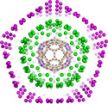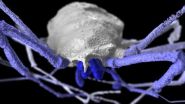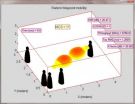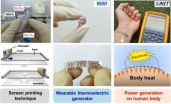(Press-News.org) Builders and factory workers know that getting a job done right requires precision and specialized tools. The same is true when you're building antibiotic compounds at the molecular level. New findings from North Carolina State University may turn an enzyme that acts as a specialized "wrench" in antibiotic assembly into a set of wrenches that will allow for greater customization. By modifying this enzyme, scientists hope to be able to design and synthesize stronger, more adaptable antibiotics from less expensive, natural compounds.
Kirromycin is a commonly known antibiotic that can be created through natural synthesis; that is, it doesn't have to be made in a chemistry lab. Nature creates compounds like kirromycin through a factory-like assembly line of enzymes where each performs a specific function, snapping different fragments of molecules together like a jigsaw puzzle. Understanding this process on the molecular level could give chemists the ability to piggyback on nature, synthesizing new antibiotics and cancer drugs with less waste and expense.
NC State chemist Gavin Williams looked at one enzyme in the kirromycin assembly line – KirCII – which is responsible for installing a molecular fragment of kirromycin at one key location. "KirCII is a linchpin enzyme in the assembly," Williams says. "Natural compounds like kirromycin get built in pieces, with small modules, or blocks of enzymes, linking up sections of the compound in a certain order. Enzymes like KirCII are the wrenches that install the molecular pieces – without them, the molecule doesn't finish assembling properly."
Williams and his team performed a molecular analysis of KirCII to determine why and how it latches onto a specific protein within the kirromycin assembly line. They saw that the enzyme has electrical charges on its surface that are complementary to opposite charges on the surface of the protein it binds with. When KirCII finds that protein, the charges match up and it snaps into place.
"We were able to see which areas on KirCII had charges that worked with the target protein," Williams says. "Hopefully we will be able to use this information to introduce complementary charges onto the surface of other proteins we want KirCII to bind with.
"Right now KirCII is just one wrench. By modifying it to fit other proteins, we could turn it into a set of different wrenches and create totally different antibiotics. Kirromycin isn't very useful right now, but by using KirCII to install pieces from other antibiotics, we'll be able to mix and match and create new, stronger antibiotics."
INFORMATION:
Williams' research appears in the April 10 Chemistry and Biology. NC State Ph.D. student Zhixia Ye contributed to the work, as did Ewa Musiol and Tilmann Weber from the Eberhard Karls University of Tübingen, Germany. The research was funded by the National Institutes of Health and the National Science Foundation.
Note to editors: An abstract of the paper follows.
"Reprogramming Acyl Carrier Protein Interactions of an Acyl-CoA Promiscuous trans-Acyltransferase"
Authors: Zhixia Ye, Gavin J. Williams, Department of Chemistry, North Carolina State University; Ewa M.Musiol, Tilmann Weber, Interfaculty Institute of Microbiology and Infection Medicine, Eberhard Karls University of Tübingen, Germany and the German Center for Infection Research, Tübingen, Germany.
Published: April 10, 2014 in Chemistry and Biology
Abstract:
Protein interactions between acyl carrier proteins (ACPs) and trans-acting acyltransferase domains (trans-ATs) are critical for regioselective extender unit installation by many polyketide synthases, yet little is known regarding the specificity of these interactions, particularly for trans-ATs with unusual extender unit specificities. Currently, the best-studied trans-AT with nonmalonyl specificity is KirCII from kirromycin biosynthesis. Here, we developed an assay to probe ACP interactions based on leveraging the extender unit promiscuity of KirCII. The assay allows us to identify residues on the ACP surface that contribute to specific recognition by KirCII. This information proved sufficient to modify a noncognate ACP from a different biosynthetic system to be a substrate for KirCII. The findings form a foundation for further understanding the specificity of trans-AT:ACP protein interactions and for engineering modular polyketide synthases to produce analogs.
Enzyme 'wrench' could be key to stronger, more effective antibiotics
2014-04-10
ELSE PRESS RELEASES FROM THIS DATE:
NEJM: High-risk seniors surgery decisions should be patient-centered, & physician led
2014-04-10
Surgery for frail, senior citizen patients can be risky. A new patient-centered, team-based approach to deciding whether these high-risk patients will benefit from surgery is championed in an April 10 Perspective of the New England Journal of Medicine. The Perspective suggests that the decision to have surgery must balance the advantages and disadvantages of surgical and non-surgical treatment as well as the patient's values and goals in a team-based setting that includes the patient, his or her family, the surgeon, the primary care physician and the physician anesthesiologist.
One ...
Virus structure inspires novel understanding of onion-like carbon nanoparticles
2014-04-10
Symmetry is ubiquitous in the natural world. It occurs in gemstones and snowflakes and even in biology, an area typically associated with complexity and diversity. There are striking examples: the shapes of virus particles, such as those causing the common cold, are highly symmetrical and look like tiny footballs.
A research programme led by Reidun Twarock at the University of York, UK has developed new mathematical tools to better understand the implications of this high degree of symmetry in these systems. The group pioneered a mathematical theory that reveals unprecedented ...
New towns going up in developing nations pose major risk to the poor
2014-04-10
DENVER (April 10, 2014) – Satellite city projects across the developing world are putting an increasing number of poor people at risk to natural hazards and climate change, according to a new study from the University of Colorado Denver.
Throughout Asia, Africa and Latin America `new towns' are rapidly being built on the outskirts of major cities with the goal of relieving population pressures, according to study author Andrew Rumbach, PhD, assistant professor of planning and design at CU Denver's College of Architecture and Planning.
The towns often sit in high flood ...
Four-eyed daddy longlegs fossil fills in evolutionary tree
2014-04-10
Living harvestmen—a group of arachnids more commonly known as daddy longlegs—have a single pair of eyes that help them navigate habitats in every continent except Antarctica. But a newly described 305-million-year-old fossil found in eastern France shows that wasn't always the case. New research recently published in the journal Current Biology and led by scientists at the American Museum of Natural History and the University of Manchester indicates that primitive harvestmen had two pairs of eyes, adding significant details to the evolutionary story of this diverse and ...
New research on gigabit wireless communications
2014-04-10
Research on gigabit wireless communications has been presented by researchers from the University of Bristol at the world's leading wireless communications and networking conference, IEEE WCNC 2014, in Turkey earlier this week [Monday 6 to Wednesday 9 April].
The two research papers, led by Andrew Nix, Professor of Wireless Communication Systems and Dr Simon Armour, Senior Lecturer in Software Radio, from the University's Communication Systems and Networks research group in the Department of Electrical and Electronic Engineering, could have significant implications for ...
Thermoelectric generator on glass fabric for wearable electronic devices
2014-04-10
Wearable computers or devices have been hailed as the next generation of mobile electronic gadgets, from smart watches to smart glasses to smart pacemakers. For electronics to be worn by a user, they must be light, flexible, and equipped with a power source, which could be a portable, long-lasting battery or no battery at all but a generator. How to supply power in a stable and reliable manner is one of the most critical issues to commercialize wearable devices.
A team of KAIST researchers headed by Byung Jin Cho, a professor of electrical engineering, proposed a solution ...
Common sense health for young adult cancer survivors
2014-04-10
Many factors influence the life expectancy of childhood cancer survivors: not getting enough exercise, being underweight, and being worried about their future health or their health insurance. These are the findings of research led by Cheryl Cox of the St. Jude Children's Research Hospital in the US, published in Springer's Journal of Cancer Survivorship. The study found that, on average, childhood cancer survivors passed away before they were 40 years old.
Health-related behavior, self-perceived health status, and health concerns often influence mortality in the general ...
Iconic boreal bird species declining in the Adirondacks, study says
2014-04-10
A new study from the Wildlife Conservation Society finds that several iconic Adirondack birds are in trouble, with declines driven by the size of their wetland habitats, how connected these wetlands are to one another, and how near they are to human infrastructure.
The Adirondack Park represents the southern range extent for several species of boreal forest birds in eastern North America. Like any species at the edge of its range, they face challenges in this environment. The habitats of these boreal specialists – cool, wet, sphagnum-draped bogs and swampy woods – are ...
Uncovering a new angle on mental distance
2014-04-10
Why does the second hour of a journey seem shorter than the first? According to research from University of Toronto Scarborough (UTSC) and the Rotman School of Management, the answer lies in how we're physically oriented in space.
In a series of six studies, Sam Maglio, an assistant professor in UTSC's Department of Management, demonstrated that a person's orientation — the direction they are headed — changed how they thought of an object or event.
The research is forthcoming in Psychological Science, a journal of the Association for Psychological Science.
"Feeling ...
Sunlight generates hydrogen in new porous silicon
2014-04-10
Porous silicon manufactured in a bottom up procedure using solar energy can be used to generate hydrogen from water, according to a team of Penn State mechanical engineers, who also see applications for batteries, biosensors and optical electronics as outlets for this new material.
The surface area of this porous silicon is high," said Donghai Wang, assistant professor of mechanical engineering. "It is widely used and has a lot of applications."
The standard method for manufacturing porous silicon is a subtraction method, similar to making a sculpture.
"Silicon is ...



